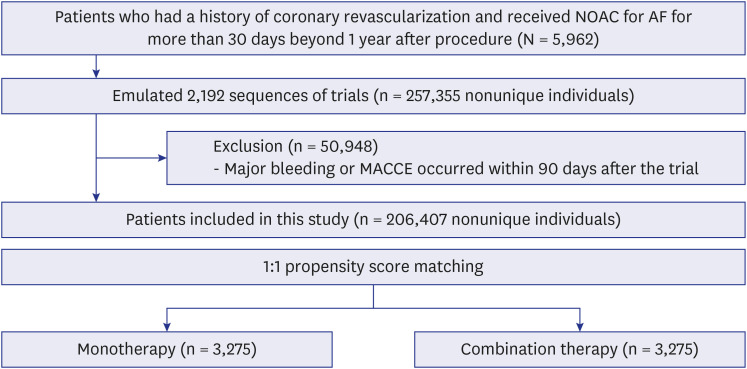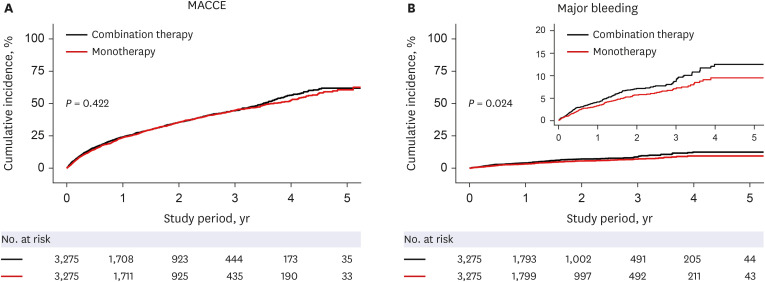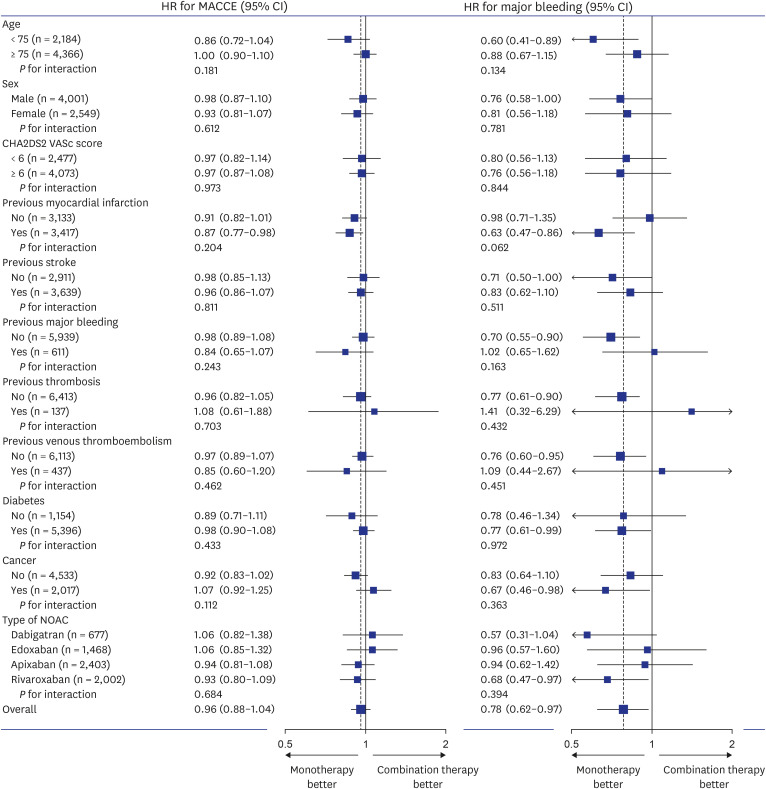J Korean Med Sci.
2024 Jun;39(24):e191. 10.3346/jkms.2024.39.e191.
Optimal Antithrombotic Therapy Beyond 1-Year After Coronary Revascularization in Patients With Atrial Fibrillation
- Affiliations
-
- 1Division of Cardiology, Department of Medicine, Samsung Medical Center, Sungkyunkwan University School of Medicine, Seoul, Korea
- 2Center for Clinical Epidemiology, Samsung Medical Center, Sungkyunkwan University School of Medicine, Seoul, Korea
- 3Division of Environmental Epidemiology, Johns Hopkins Bloomberg School of Public Health, Baltimore, MD, USA
- KMID: 2556687
- DOI: http://doi.org/10.3346/jkms.2024.39.e191
Abstract
- Background
Currently, non-vitamin K-antagonist oral anticoagulant (NOAC) monotherapy has been suggested as the optimal antithrombotic therapy for atrial fibrillation (AF) beyond one year after coronary revascularization. The aim of this study was to compare the outcomes between NOAC monotherapy and NOAC plus antiplatelet combination therapy using realworld data.
Methods
Between 2015 and 2020, patients with AF who had received NOACs beyond one year after coronary revascularization were enrolled from Korean national insurance data. We emulated a pragmatic sequence of trials between the NOAC monotherapy and the antiplatelet combination therapy followed by propensity score matching. The primary endpoint was major adverse cardiac and cerebrovascular events (MACCEs), a composite of all-cause death, myocardial infarction, and stroke.
Results
Among 206,407 person-trials from 4,465 individuals, we compared 3,275 pairs of the monotherapy and the matched combination therapy. During a median follow-up of 1.24 years, the incidence rate of MACCE was 19.4% and 20.0% per patient-year in the monotherapy group and the antiplatelet combination group, respectively (hazard ratio [HR], 0.96; 95% confidence interval [CI], 0.88–1.05; P = 0.422). Compared with the antiplatelet combination group, the monotherapy group had a significantly lower incidence rate of major bleeding, defined as intracranial bleeding or gastrointestinal bleeding requiring hospitalization (2.8% vs. 3.6% per patient-year; HR, 0.78; 95% CI, 0.62–0.97; P = 0.024).
Conclusion
As an antithrombotic therapy for AF beyond one year after coronary revascularization, NOAC monotherapy was associated with a similar risk of MACCE and a lower risk of major bleeding compared to NOAC plus antiplatelet combination therapy.
Figure
Reference
-
1. Lopes RD, Hong H, Harskamp RE, Bhatt DL, Mehran R, Cannon CP, et al. Optimal antithrombotic regimens for patients with atrial fibrillation undergoing percutaneous coronary intervention: an updated network meta-analysis. JAMA Cardiol. 2020; 5(5):582–589. PMID: 32101251.
Article2. Lopes RD, Heizer G, Aronson R, Vora AN, Massaro T, Mehran R, et al. Antithrombotic therapy after acute coronary syndrome or PCI in atrial fibrillation. N Engl J Med. 2019; 380(16):1509–1524. PMID: 30883055.
Article3. Hansen ML, Sørensen R, Clausen MT, Fog-Petersen ML, Raunsø J, Gadsbøll N, et al. Risk of bleeding with single, dual, or triple therapy with warfarin, aspirin, and clopidogrel in patients with atrial fibrillation. Arch Intern Med. 2010; 170(16):1433–1441. PMID: 20837828.
Article4. Hahn JY, Song YB, Oh JH, Chun WJ, Park YH, Jang WJ, et al. Effect of P2Y12 inhibitor monotherapy vs dual antiplatelet therapy on cardiovascular events in patients undergoing percutaneous coronary intervention: the SMART-CHOICE randomized clinical trial. JAMA. 2019; 321(24):2428–2437. PMID: 31237645.5. Valgimigli M, Frigoli E, Heg D, Tijssen J, Jüni P, Vranckx P, et al. Dual antiplatelet therapy after PCI in patients at high bleeding risk. N Engl J Med. 2021; 385(18):1643–1655. PMID: 34449185.6. Wang TY, Robinson LA, Ou FS, Roe MT, Ohman EM, Gibler WB, et al. Discharge antithrombotic strategies among patients with acute coronary syndrome previously on warfarin anticoagulation: physician practice in the CRUSADE registry. Am Heart J. 2008; 155(2):361–368. PMID: 18215609.7. Morita Y, Hamaguchi T, Yamaji Y, Hayashi H, Nakane E, Haruna Y, et al. Temporal trends in prevalence and outcomes of atrial fibrillation in patients undergoing percutaneous coronary intervention. Clin Cardiol. 2020; 43(1):33–42. PMID: 31696533.8. Hindricks G, Potpara T, Dagres N, Arbelo E, Bax JJ, Blomström-Lundqvist C, et al. 2020 ESC guidelines for the diagnosis and management of atrial fibrillation developed in collaboration with the European Association for Cardio-Thoracic Surgery (EACTS): the task force for the diagnosis and management of atrial fibrillation of the European Society of Cardiology (ESC) developed with the special contribution of the European Heart Rhythm Association (EHRA) of the ESC. Eur Heart J. 2021; 42(5):373–498. PMID: 32860505.9. Angiolillo DJ, Bhatt DL, Cannon CP, Eikelboom JW, Gibson CM, Goodman SG, et al. Antithrombotic therapy in patients with atrial fibrillation treated with oral anticoagulation undergoing percutaneous coronary intervention: a North American perspective: 2021 update. Circulation. 2021; 143(6):583–596. PMID: 33555916.
Article10. January CT, Wann LS, Calkins H, Chen LY, Cigarroa JE, Cleveland JC Jr, et al. 2019 AHA/ACC/HRS focused update of the 2014 AHA/ACC/HRS guideline for the management of patients with atrial fibrillation: a report of the American College of Cardiology/American Heart Association task force on clinical practice guidelines and the Heart Rhythm Society in collaboration with the Society of Thoracic Surgeons. Circulation. 2019; 140(2):e125–e151. PMID: 30686041.
Article11. Alexander JH, Lopes RD, Thomas L, Alings M, Atar D, Aylward P, et al. Apixaban vs. warfarin with concomitant aspirin in patients with atrial fibrillation: insights from the ARISTOTLE trial. Eur Heart J. 2014; 35(4):224–232. PMID: 24144788.
Article12. Hamon M, Lemesle G, Tricot O, Meurice T, Deneve M, Dujardin X, et al. Incidence, source, determinants, and prognostic impact of major bleeding in outpatients with stable coronary artery disease. J Am Coll Cardiol. 2014; 64(14):1430–1436. PMID: 25277612.
Article13. Lamberts M, Gislason GH, Lip GY, Lassen JF, Olesen JB, Mikkelsen AP, et al. Antiplatelet therapy for stable coronary artery disease in atrial fibrillation patients taking an oral anticoagulant: a nationwide cohort study. Circulation. 2014; 129(15):1577–1585. PMID: 24470482.
Article14. Yasuda S, Kaikita K, Akao M, Ako J, Matoba T, Nakamura M, et al. Antithrombotic therapy for atrial fibrillation with stable coronary disease. N Engl J Med. 2019; 381(12):1103–1113. PMID: 31475793.
Article15. Matsumura-Nakano Y, Shizuta S, Komasa A, Morimoto T, Masuda H, Shiomi H, et al. Open-label randomized trial comparing oral anticoagulation with and without single antiplatelet therapy in patients with atrial fibrillation and stable coronary artery disease beyond 1 year after coronary stent implantation. Circulation. 2019; 139(5):604–616. PMID: 30586700.
Article16. Kim D, Yang PS, You SC, Sung JH, Jang E, Yu HT, et al. Treatment timing and the effects of rhythm control strategy in patients with atrial fibrillation: nationwide cohort study. BMJ. 2021; 373(991):n991. PMID: 33975876.
Article17. Lee J, Lee JS, Park SH, Shin SA, Kim K. Cohort profile: the National Health Insurance Service-National Sample Cohort (NHIS-NSC), South Korea. Int J Epidemiol. 2017; 46(2):e15. PMID: 26822938.
Article18. Chun CB, Kim SY, Lee JY, Lee SY. Republic of Korea: health system review. Health Syst Transit. 2009; 11(7):1–184.19. Kim J, Kang D, Kim SE, Park H, Park TK, Lee JM, et al. Comparison between fimasartan versus other angiotensin receptor blockers in patients with heart failure after acute myocardial infarction. J Korean Med Sci. 2023; 38(25):e202. PMID: 37365730.
Article20. Shin DW, Cho B, Guallar E. Korean National Health Insurance Database. JAMA Intern Med. 2016; 176(1):138.
Article21. Kimm H, Yun JE, Lee SH, Jang Y, Jee SH. Validity of the diagnosis of acute myocardial infarction in Korean national medical health insurance claims data: the Korean Heart Study (1). Korean Circ J. 2012; 42(1):10–15. PMID: 22363378.
Article22. Tsivgoulis G, Wilson D, Katsanos AH, Sargento-Freitas J, Marques-Matos C, Azevedo E, et al. Neuroimaging and clinical outcomes of oral anticoagulant-associated intracerebral hemorrhage. Ann Neurol. 2018; 84(5):694–704. PMID: 30255970.
Article23. Lip GY, Nieuwlaat R, Pisters R, Lane DA, Crijns HJ. Refining clinical risk stratification for predicting stroke and thromboembolism in atrial fibrillation using a novel risk factor-based approach: the euro heart survey on atrial fibrillation. Chest. 2010; 137(2):263–272. PMID: 19762550.
Article24. García-Albéniz X, Hsu J, Bretthauer M, Hernán MA. Effectiveness of screening colonoscopy to prevent colorectal cancer among Medicare beneficiaries aged 70 to 79 years: a prospective observational study. Ann Intern Med. 2017; 166(1):18–26. PMID: 27669524.
Article25. Caniglia EC, Rojas-Saunero LP, Hilal S, Licher S, Logan R, Stricker B, et al. Emulating a target trial of statin use and risk of dementia using cohort data. Neurology. 2020; 95(10):e1322–e1332. PMID: 32753444.
Article26. Hernán MA, Sauer BC, Hernández-Díaz S, Platt R, Shrier I. Specifying a target trial prevents immortal time bias and other self-inflicted injuries in observational analyses. J Clin Epidemiol. 2016; 79:70–75. PMID: 27237061.
Article27. Matteau A, Yeh RW, Camenzind E, Steg PG, Wijns W, Mills J, et al. Balancing long-term risks of ischemic and bleeding complications after percutaneous coronary intervention with drug-eluting stents. Am J Cardiol. 2015; 116(5):686–693. PMID: 26187674.
Article28. Kwon S, Jung JH, Choi EK, Lee SW, Park J, Lee SR, et al. Impact of non-vitamin K antagonist oral anticoagulants on the change of antithrombotic regimens in patients with atrial fibrillation undergoing percutaneous coronary intervention. Korean Circ J. 2021; 51(5):409–422. PMID: 33764010.
Article29. Capodanno D, Di Maio M, Greco A, Bhatt DL, Gibson CM, Goette A, et al. Safety and efficacy of double antithrombotic therapy with non-vitamin K antagonist oral anticoagulants in patients with atrial fibrillation undergoing percutaneous coronary intervention: a systematic review and meta-analysis. J Am Heart Assoc. 2020; 9(16):e017212. PMID: 32805186.
Article30. van Rein N, Heide-Jørgensen U, Lijfering WM, Dekkers OM, Sørensen HT, Cannegieter SC. Major bleeding rates in atrial fibrillation patients on single, dual, or triple antithrombotic therapy. Circulation. 2019; 139(6):775–786. PMID: 30586754.
Article
- Full Text Links
- Actions
-
Cited
- CITED
-
- Close
- Share
- Similar articles
-
- Antithrombotic Strategy in Atrial Fibrillation Patients Undergoing Percutaneous Coronary Intervention
- Antithrombotic Therapy for Patients with Nonvalvular Atrial Fibrillation
- Simultaneously Presented Acute Ischemic Stroke and Non-ST Elevation Myocardial Infarction in a Patient with Paroxysmal Atrial Fibrillation
- Pathophysiology and Diagnosis in Atrial Fibrillation
- A Case of Paroxysmal Atrial Fibrillation and Sinus Bradycardia due to Coronary Artery Spasm




